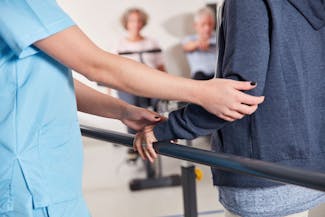
What is a balance disorder?
A balance disorder is a condition that makes you feel unsteady or dizzy. If you are standing, sitting, or lying down, you might feel as if you are moving, spinning, or floating. If you are walking, you might suddenly feel as if you are tipping over.
Everyone has a dizzy spell now and then, but the term "dizziness" can mean different things to different people. For one person, dizziness might mean a fleeting feeling of faintness, while for another it could be an intense sensation of spinning (vertigo) that lasts a long time.
Experts believe that more than four out of 10 Americans, sometime in their lives, will experience an episode of dizziness significant enough to send them to a doctor. Balance disorders can be caused by certain health conditions, medications, or a problem in the inner ear or the brain. A balance disorder can profoundly impact daily activities and cause psychological and emotional hardship.
What are the symptoms of a balance disorder?
If you have a balance disorder, you may stagger when you try to walk, or teeter or fall when you try to stand up. You might experience other symptoms such as:
- Dizziness or vertigo (a spinning sensation)
- Falling or feeling as if you are going to fall
- Lightheadedness, faintness, or a floating sensation
- Blurred vision
- Confusion or disorientation.
Other symptoms might include nausea and vomiting, changes in heart rate and blood pressure, and fear, anxiety, or panic.
Symptoms may come and go over short time periods or last for a long time, and can lead to fatigue and depression.What causes balance disorders?
There are many causes of balance problems, such as medications, ear infections, a head injury, or anything else that affects the inner ear or brain. Low blood pressure can lead to dizziness when you stand up too quickly. Problems that affect the skeletal or visual systems, such as arthritis or eye muscle imbalance, can also cause balance disorders. Your risk of having balance problems increases as you get older.
What is GAIT
Gait examination is the analysis of walking problems by visually examining the interaction of the low back and the joints of the thighs, legs, and feet during the various stages of walking.
When performing a gait examination various stages of walking are observed including, initial contact, loading response, mid stance, terminal stance, pre swing, mid swing, and terminal swing.
Many back, thigh, leg, ankle, and foot problems may be caused by or manifest themselves in subtle gait abnormalities.
Gait training involves retraining the patient to improve their ability to walk as close to normal again. This training may involve:
- Stretching
- Strengthing
- Endurance exercise
- Balance exercises
- Visual/video training with feedback
- Verbal cues to improve walking patterns
- Training on different surfaces (grass, stairs, pavement, uneven surfaces)
There are a number of patients that can benefit from gait training including:
- Post-surgical hip, knee, ankle, foot patients
- Post-fracture patients
- Post-surgical spine surgery patients
- Patients with injuries to joints
- Patients with spinal cord injuries
- Vestibular/vertigo patients
- Neurologically involved patients
- Patients at risk for falls
- Stroke patients
- Numerous others
